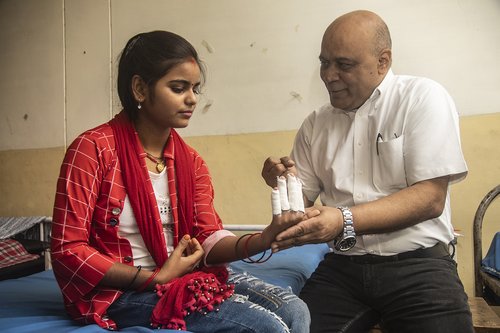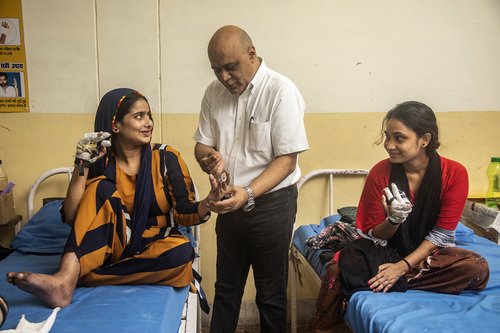The battle to defeat leprosy: 40 years of Multidrug therapy
Leprosy is considered one of the oldest known infectious diseases. Some research says it could date as far back as the prehistoric era. So, what a groundbreaking discovery it was in 1873 when a Norwegian scientist, Gerhard-Henrik Armauer Hansen, discovered that leprosy was in fact caused by the bacteria Mycobacterium leprae. Until then, it had often been assumed that leprosy was a genetic disease, or even a curse.
Since ancient times, people all over the world have been marginalised, isolated and stigmatised because of leprosy. Forced out of their communities and confined to leprosy villages and hospitals, abandoned by their families.
Dr Premal Das is a reconstructive surgeon and heads up The Leprosy Mission's work in India. He has restored mobility to disabled hands and feet for more than 30 years. But in fact, Dr Premal has an even longer history with leprosy. His grandfather was a Leprosy Mission doctor in the 1890s. His father, uncle, aunts, and cousins also served the Mission as doctors and surgeons. Dr Premal and his wife, Dr Loretta, joined The Leprosy Mission in 1985.

Dr Premal recalls being a young child, at hospital with his father, in the sixties. He says: “I remember seeing young children coming to the hospital. The whole family would be crying. You would be left at the hospital for the rest of your life”. Leprosy tore families apart, and the heartache was unbearable.
Thankfully, Hansen’s devotion to a lifetime of scientific research changed the face of leprosy treatment. As a result, rates of the disease started to decline in much of Europe.
A cure for leprosy
Hansen’s discoveries about leprosy were a breakthrough. It meant that advances in research could be made. But it wasn’t until a century later that the next amazing breakthrough in the battle against leprosy would be made. The first effective treatment for leprosy, promin, became available in the 1940s. By 1950s dapsone was introduced. The search for further effective anti-leprosy drugs continued through the 1960s and 70s.
The greatest step forward, however, was in 1982 when doctors and scientists trialled the first combination-type drug therapy where three different antibiotics were used. The drug combination, aptly named Multidrug therapy (MDT), was a gamechanger. For the first time it was possible to cure leprosy once and for all.

Previously, a lifetime of medication was required simply to 'manage' the disease. But with MDT, a person was no longer infectious after just two weeks of treatment. Dr Premal says, “I knew Multidrug therapy was on its way when I was a medical student in Vellore. Drug trials which lasted a decade took place in Malta during the ‘70s”.
This year marks 40 years since the first Multidrug therapy was used to cure a person with the early symptoms of leprosy. In the last 20 years alone, an astounding 16 million people have been cured of the disease.
As organisations and charities began prescribing MDT in the early 1980s, Mother Teresa launched an awareness campaign to educate patients and medical professionals alike. Finally, there was hope that the end of leprosy was in sight.
Cured but not eradicated
So, if there is a cure, why has leprosy still not been eradicated, 40 years down the line? Dr Premal says, “The rollout of Multidrug therapy was slow; it was 1995 before it reached every part of India”. But by 1991, the World Health Assembly (WHA) had already adopted a resolution to ‘eliminate leprosy by the year 2000’ – a mere five years after the drug had reached parts of India and using a definition of elimination that simply means there is less than one registered case of leprosy per 10,000 people – not, as you may have thought, that leprosy no longer exists.
Globally, leprosy did decline rapidly after the introduction of MDT, and the ‘elimination of leprosy’ globally was declared in the year 2000. But this remarkable achievement doesn’t provide a realistic picture of leprosy. The concept of the “elimination of leprosy as a public health problem” is largely dependent on whose perspective it’s coming from. And as we know, there are so many barriers to people even being diagnosed to begin with. Many live a long way from a hospital or clinic. Others fear a diagnosis of leprosy and delay seeking treatment as a result.

There were many barriers, too, to the roll out of MDT. Dr Premal says, “My first few years at The Leprosy Mission were spent in the community, finding, and curing leprosy”. The methods of case finding and treatment were crude. He says, “We would carry large jars of water and set up a village clinic under a tree. Multidrug therapy was an expensive medicine and there was a vibrant black market, sot had to be given as a supervised dose. We had to make sure the medicine had been swallowed by pouring water down patients’ throats”.
Case finding and the administration of MDT has changed and improved since then.
Dr Premal recalls, “In my lifetime alone so much has changed because of this treatment. The other day I was at an outpatients' department and there were ten new leprosy cases in just that one morning. The patients had a skin smear, saw a physiotherapist and then a counsellor. They then went home with their Multidrug therapy at the end of the day. It is truly amazing how far we have come”.
What’s next?
The biggest barrier to ending leprosy now is not the availability or even the affordability of the cure. Finding new cases of leprosy is still a huge obstacle in the countries we serve. Research shows that only five per cent of leprosy cases are being cured globally. There are still millions of people living with untreated leprosy today. These people desperately need a diagnosis so that they too can receive the cure. There is a real urgency for early diagnosis before disability sets in.
The number of new cases of leprosy diagnosed every year has remained fairly static over the last two decades, although there are differences among countries. One important indicator of ongoing transmission is the proportion of new cases detected in children under 15. These cases are on the increase.
Efforts to end leprosy will now depend on a better understanding of the transmission of the disease and new tools that will stop people passing on the disease in its early stages. Dr Premal says the focus needs to be on new diagnostic tools that will show who has been infected by leprosy – and how.

“Treating leprosy in its early stages is vital to prevent disability. Better diagnostic tools are the way forward. Catching the disease early is essential to stop the spread. It is paramount to ending leprosy,” he said.
Because of your support, research for two diagnostic tests is currently being carried out at Anandaban Hospital in Nepal. These tests would allow more people to be diagnosed and treated than ever before.
“The challenge now is that we need more new drugs and treatments,” said Dr Premal. “We need to be prepared for resistance to the Multidrug therapy medicines”. When we talk about the cure for leprosy, many people want to know when there will be a vaccine for the disease. “The Covid vaccines showed us how quickly drugs can be developed and approved,” said Dr Premal. “But that is if there is finance and political intent behind them. Leprosy is not like Covid. It’s a poor person’s disease affecting poor countries, and therefore low priority”.
We are so thankful for the progress that has been made in the fight against leprosy so far. We celebrate the wins, and we celebrate 40 years of Multidrug therapy, the first effective cure. It’s with your support that treatment, surgery, case finding and research projects that have made such a difference have taken place. As we look ahead to the next 40 years of leprosy treatment, we look forward to the day when we really will see the end of the disease.
*Photos: Sabrina Dangol and Ricardo Franco